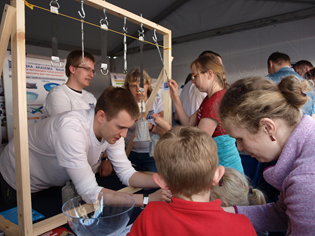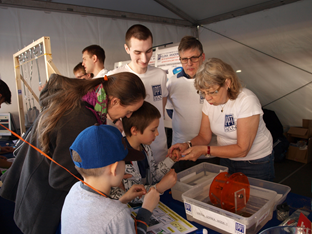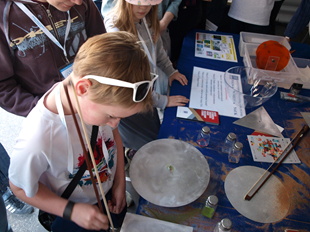
On May 11 2019, our Institute participated in the 23 Science Picnic of Polish Radio and the Copernicus Science Centre, this year dedicated to “We and the machines”.
The Warsaw Science Picnic of the Polish Radio and the Copernicus Science Centre is Europe’s largest outdoor event dedicated to science. In our stand, organized by doctoral students of IPPT together with research workers, the audiences of various ages attended scientific presentations. The picnic achieved great interest from the inhabitants of Warsaw.
 |
 |
 |
 |
Program:
Authors: Elżbieta Pieczyska (coordynator) and team: Katarzyna Czarnecka, Karol Golasiński, Oliwia Jeznach, Jan Kraskowski, Dominik Kukla, Michał Majewski, Michał Milczarek, Artur Myczka, Kamil Opiela, Błażej Popławski, Rafał Psiuk, Maria Staszczak, Michał Wichrowski
HOW IS REALITY SIMPLIFIED IN NUMERICAL SIMULATIONS?
Presentation 1: Using of a mathematical tool - Finite Element Method for engineering calculations
The Finite Element Method (FEM) is a numerical tool that converts a set of differential equations into equation systems solved by a computing machine. The method is successfully used in numerical simulations of various structures, e.g. cars, spacecrafts, buildings. Visitors of the Science Picnic listened to a short introduction about FEM. Then the IPPT staff carried out the uniaxial stretching of a flexible sample and presented its simplified model made by springs. The visitors, with a support of the IPPT team, made simplified models composed on springs (finite elements) and connectors (nodes) of geometrically various samples from the flexible tape. In this way the idea of discretization of the continuous medium (sample) with finite elements (springs and nodes) was demonstrated.
STRAIN MEASUREMENT WITH THE USE OF RESISTANCE STRAIN GAUGE TECHNIQUE
Presentation 2: Measurement of specimen deformation
The method of deformation measurement of a mechanically loaded specimen using the resistance strain gauge technique has been presented. Visitors could perform a simple experiment. They loaded the specimen and observed the deformation value recorded by the extensometer on the presented graph displayed on the computer monitor. Such experiments are conducted at the IPPT PAN for investigation of innovative construction materials, including composites, multifunctional alloys and polymers.
CAN MATERIALS MEMORISE THEIR SHAPE?
Presentation 3: Shape memory effects in TiNi shape memory alloy
Examples of TiNi shape memory alloy (SMA) samples were shown. Their structure and properties were explained. It was demonstrated how the SMA shape and dimensions change depending on temperature. The possible applications of such materials were presented. Volunteers deformed SMA wires, springs or clips. After immersing them in hot water the samples recovered their former shapes and sizes. The observed effects result from the crystallographically reversible martensitic transformation, which can be stress- or temperature-induced.
"AND YET IT MOVES" as GALILEO GALILEI said – SOLID STATE ENGINE
Presentation 4: Application of shape memory alloys in solid state engine
Model of a solid state engine, using the SMA shape memory effect, was demonstrated as an example of practical applications of shape memory alloys. The engine was designed and performed by students of the AICHI Institute of Technology AIT in Japan and gifted to the IPPT PAN. When the engine was partly put in the hot water, its spectacular rotation was observed. The rotation rate depends on the water temperature – the higher temperature the higher the rotation rate was obtained.
VIBRATING PICTURES
Presentation 5: Mechanical vibrations, standing wave and resonance
Visitors could get familiar with the problem of construction vibrations, which are extremely important for many buildings and machines. The IPPT staff explained the issue of the natural frequency (resonant) of structures and their corresponding forms using especially prepared metal plates of various sizes and shapes. The basic indicator of excitation of the frequency in the plate was the generated sound. The phenomenon of own forms was presented by vibrating plates sprinkled with colored sand, which was arranged in accordance with the nodal lines of a given form of the vibration, obtaining so-called Chladni figures. Visitors could observe the described phenomena on a plate that were excited by a special generator or, could try to induce resonance vibrations in one of the prepared plates by themselves using a bow.









